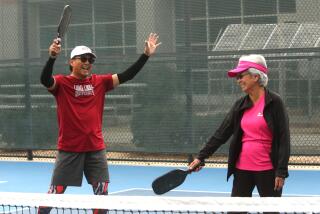Health Study Grows Older--and Better : Research: UCSD doctor briefs Rancho Bernardo residents on the benefits that have come from the study they have been part of for 20 years.
- Share via
Dr. Elizabeth Barrett-Connor has been analyzing aging in Rancho Bernardo for the past 20 years, but it hasn’t gotten old to her.
“If anything, I’m more excited about it now than when I started because we have much more information now, and I know so much more,” said the UCSD researcher whose long-running study of more than 5,000 Rancho Bernardo residents has resulted in numerous scientific papers on the effects of cigarette smoking, exercise and diet on the health of people over 50.
In her first speech ever to the people who provided the basis for much of her research over the past two decades, Barrett-Connor cited a lengthy list of findings that came as a result of their participation, such as the relationship between hormones and heart disease, and the fact that “men who are married to women who are less educated than they are live longer . . . . The research drew attention to the idea that estrogen replacement might fight heart disease . . . You did that,” Barrett-Connor told the group of about 150 participants in the study who gathered at the Oaks North Community Center.
And she isn’t done with them.
The next stage of the study begins in mid-May as Barrett-Connor and her team of researchers continue to study the same cohort of subjects, this time looking for more information on diabetes and heart disease, as well as diving into the maladies of memory loss, arthritis, cancer and risks for bone loss.
The Rancho Bernardo study began in 1972, with researchers using a trailer resting in what was an empty dirt lot but is now a strip mall. Three-by-five cards and shoe boxes were their data storage and retrieval instruments.
Back then, the subjects, all of whom lived in Rancho Bernardo and were over 30 years old, were given simple 15-minute physical examinations measuring cholesterol levels, blood pressure, height, weight, and blood glucose levels.
“It was a very primitive, do-it-yourself program,” Barrett-Connor said.
Now, the data fills a mainframe computer and several personal computers, and keeps three statisticians employed full-time. The examinations have stretched out to more than three hours, and Barrett-Connor told the participants that the next set of physicals will take two sessions.
James Doty, 75, has been part of the study since its inception and said he was excited about moving on to the next phase.
“I really enjoy it,” Doty said. “You become a statistic, and from the statistics they break it down to find out what caused a condition or corrected a condition, and it’s exciting to know that you are part of it.”
Doty said he has changed his diet dramatically in light of the findings of the continuing study.
“I never ate salads before, and now I’m eating them. I was more or less a meat and vegetables eater, and now I eat very little red meat,” he said.
Rancho Bernardo was chosen for the study because of its distance from UCSD (“not too close, not too far”), the right size (half of the then-10,000 residents of the community participated in the study), enthusiasm for the project by community leaders and educational homogeneity, Barnett-Connor said.
She is now seeking more subjects for a new study on osteoporosis in women. Participants must be women between the ages of 55 and 80 who plan to remain in the area for the next four years and have below-normal bone density.
More to Read
Sign up for Essential California
The most important California stories and recommendations in your inbox every morning.
You may occasionally receive promotional content from the Los Angeles Times.










